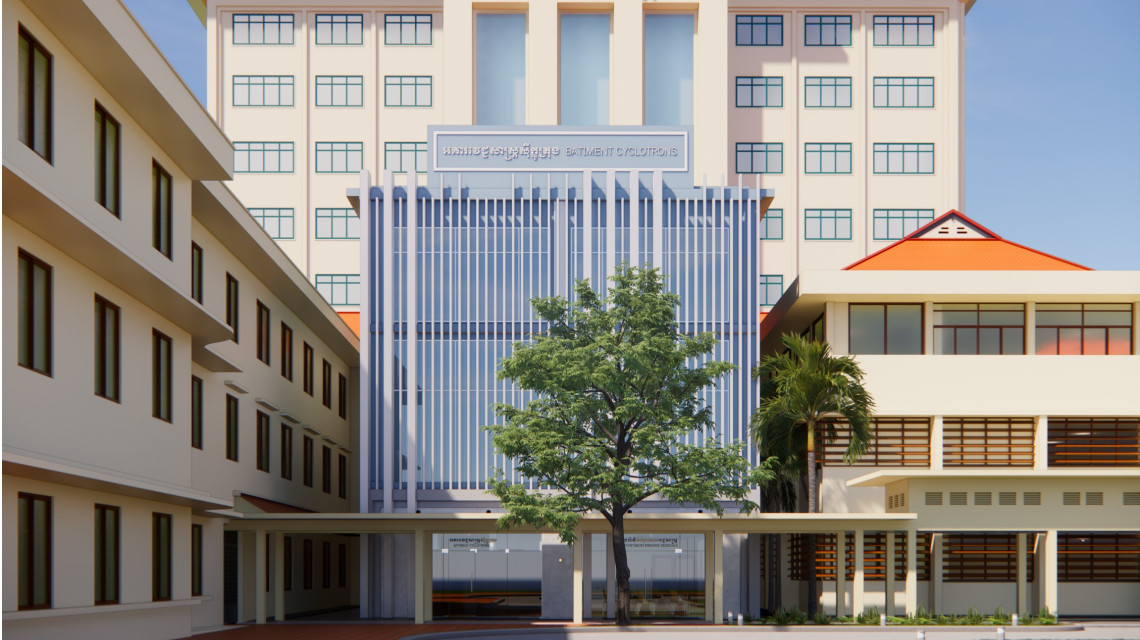Cambodia has taken significant steps to improve its cancer control capabilities — launching a new National Cancer Control Plan and initiating projects to improve its capacity to diagnose and treat cancer. This includes starting construction of the country’s first cyclotron facility which will enable radioisotopes to be produced locally for medical imaging and treatment.
Cambodia Working to Improve Cancer Care
Installation of LINAC at Luang Mè Hospital. The IAEA supported the hospital by reviewing plans for the bunker and training specialized staff. (Photo: Luang Me Hospital)
Cancer in Cambodia
In 2022, close to 20 000 Cambodians were diagnosed with cancer (Globocan, 2022). For women, the most frequently diagnosed cancer types were of the breast, cervix and liver — together accounting for more than 40 per cent of all new cancers in that year. For men, the two most frequently diagnosed cancers were of the liver and the lungs — together representing just over 40 per cent of all new male cancer cases. By 2045, overall cancer incidence in the country is expected to have doubled (Globocan, 2022).
The country’s new National Cancer Control Plan (NCCP) is expected to streamline interventions in the country and was largely informed by an IAEA imPACT Review that took place in 2023 and by the guidance of the IAEA’s health experts.
“The Cambodian Ministry of Health is fully committed to implementing the NCCP to expand the range of service delivery and enhance the quality of medical services for patients in terms of cancer prevention, screening, diagnosis, treatment, care and support,” said Beauta Rath, Advisor to the Ministry.
Advancements in cancer diagnosis and treatment

Design of the finished cyclotron building at Calmette Hospital. IAEA experts reviewed the design of the cyclotron, advised on the safety and regulatory aspects, and have been training staff on maintenance and operation. (Photo: Calmette Hospital)
The first project, initiated in 2024, was the construction of the new Cyclotron Medical Centre at Calmette Hospital in central Phnom Penh. In line with Cambodia’s long term strategy to modernize medical technology and enhance self-sufficiency in nuclear medicine, this new facility will enable radioisotopes to be produced locally, significantly expanding access to advanced diagnostic imaging for patients across the country. Throughout the process, the IAEA’s health specialists have provided expertise and guidance.
The second project, also launched in 2024, was the transformation of Luang Me, previously a maternity hospital, into a specialised cancer treatment centre poised to provide comprehensive cancer treatment services to Cambodia’s patients. Located slightly outside Phnom Penh, the extra 300 beds available at this facility are intended to expand access for regional patients whilst relieving the pressure and waiting times for patients attending Calmette Hospital. The centre is already providing surgery and emergency services and has now also begun to provide radiotherapy treatment.
Through its technical cooperation and human health programmes, the IAEA has not only helped commission linear accelerators and imaging equipment for Cambodia but has also trained doctors, provided advice on construction and bunkers and assisted with installation. The 2023 imPACT Review mission involved visiting the centre and discussing national plans and capacity building needs.
Both developments mark a major step toward improving cancer diagnosis and treatment for patients in Cambodia. In addition to these large-scale infrastructure projects, Cambodia is expanding its radiotherapy and nuclear medicine services with IAEA support for training, including at the Khmer Soviet Friendship Hospital — the first hospital in the country to have started providing radiotherapy.
Improving access to cancer care

An IAEA radiotherapy medical physicist visited the Khmer Soviet Friendship Hospital in August 2024, laying the foundation for future collaboration and improvements in cancer care across Cambodia. IAEA support focuses on facility master planning, and on addressing key staffing and technical gaps to ensure the delivery of high-quality, evidence-based treatment. (Photo: Khmer Soviet Friendship Hospital)
These transformative projects are part of Cambodia’s broader efforts to control cancer, notably through the IAEA’s Rays of Hope initiative. “The new NCCP provides a framework to support the continued expansion of radiotherapy services and the development of adequate regulatory frameworks in the country,” said Joelle Saleh, Project Officer for the Rays of Hope initiative in the Technical Cooperation Department of the IAEA. “It will also enhance resource mobilization efforts, helping the country secure sustainable funding by informing the development of the funding document currently being worked on,” Saleh added.
With the new NCCP in place, Luang Me Hospital transformed, the Cyclotron Medical Centre at Calmette Hospital under construction, and the expansion of advanced cancer treatment facilities at the Khmer Soviet Friendship Hospital, Cambodia is preparing to enter a new phase for cancer control. These achievements will increase access to high-quality cancer treatment for patients in the country.






